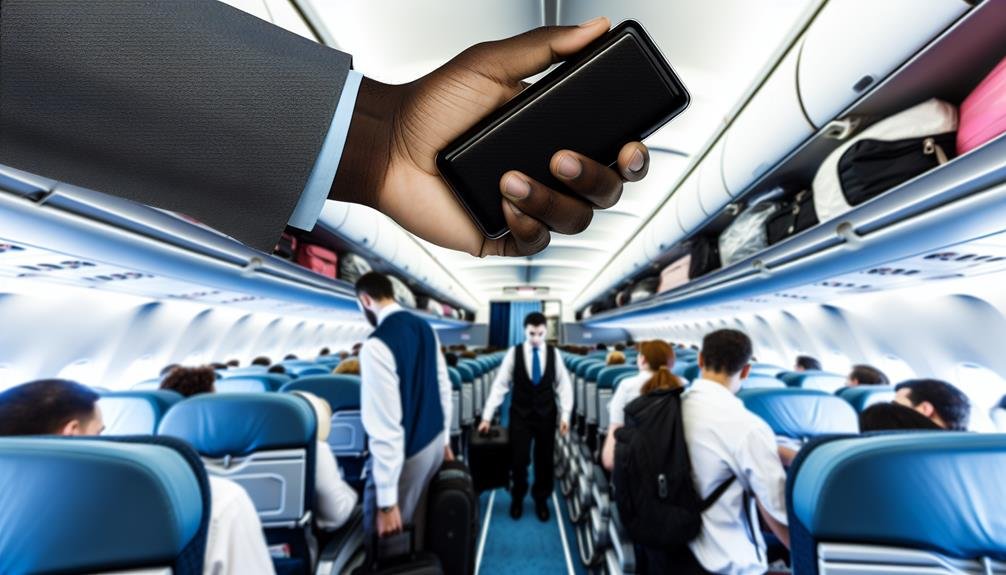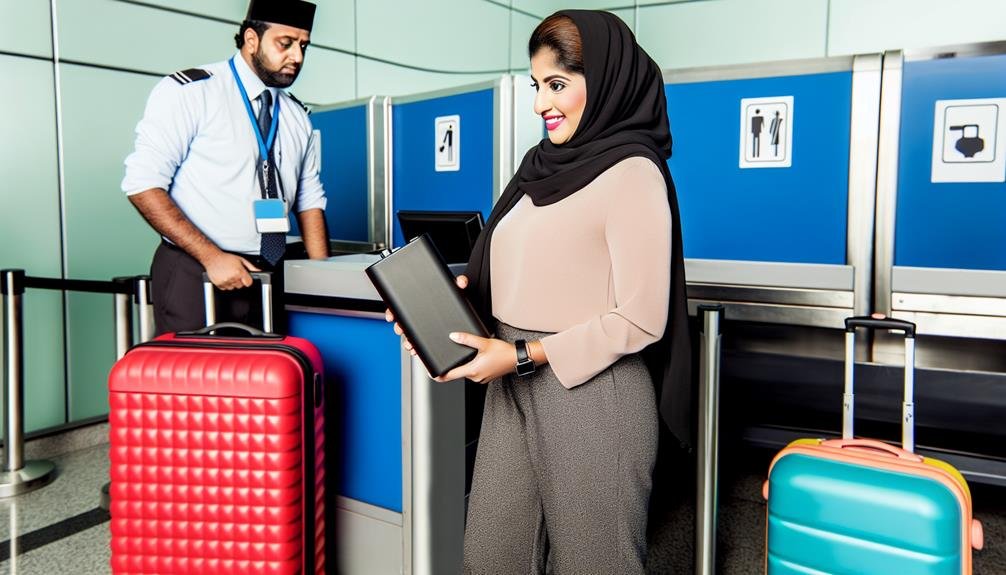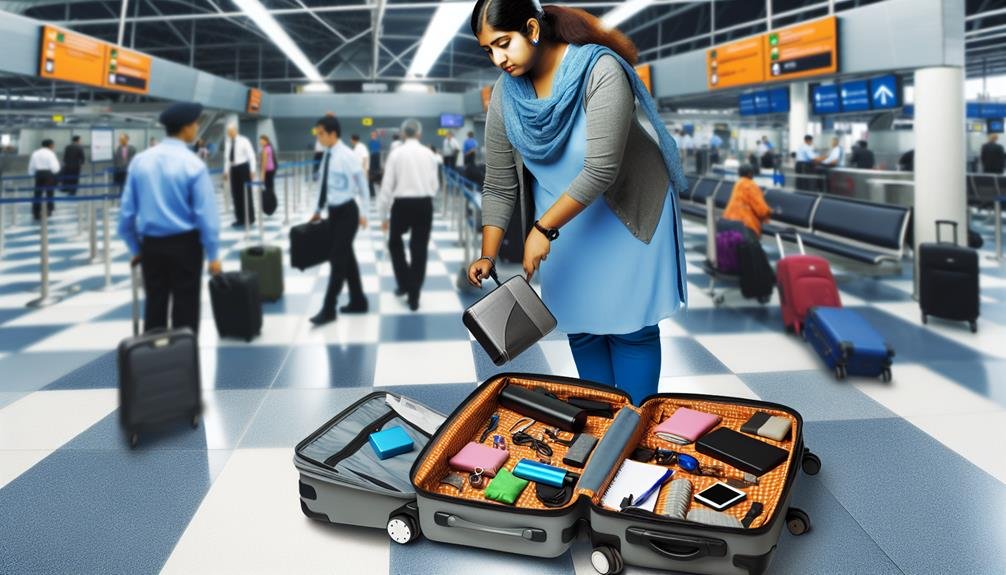You can bring lithium power banks up to 100Wh on flights without airline approval. If your power bank is between 100Wh and 160Wh, you'll need to obtain approval from the airline. Power banks exceeding 160Wh are usually prohibited in carry-on baggage. Most airlines prohibit lithium power banks in checked baggage due to fire hazards. Always verify specific policies with your airline and make sure the power bank's watt-hour rating is clearly labeled. Different airlines and countries have different regulations, so thorough preparation is crucial. For further detailed guidelines and tips, continue exploring.
Airline Regulations Overview

When traveling with large capacity lithium power banks, it's important to understand the specific airline regulations governing their transport. Airlines impose strict guidelines to guarantee passenger safety, primarily focusing on battery capacity and the potential hazards associated with lithium-ion technology.
You'll need to be aware of the watt-hour (Wh) rating of your power banks. Battery capacity is a critical factor airlines consider when determining if your device is allowed on board. Generally, power banks with a capacity of up to 100 Wh don't face stringent restrictions and can be carried in your carry-on baggage. However, for devices with capacities between 100 Wh and 160 Wh, you'll likely need airline approval before you can bring them on board.
Airline restrictions also dictate that power banks must be transported in carry-on luggage, not checked baggage. This helps mitigate risks associated with battery malfunctions, such as overheating or short-circuiting, which can be more easily managed in the cabin. Additionally, some airlines limit the number of power banks you can carry, typically allowing up to two larger capacity units per passenger. Always consult your specific airline's policy before traveling to ensure compliance and safety.
Power Bank Capacity Limits
When traveling with large capacity lithium power banks, you must be aware of the maximum capacity regulations set by aviation authorities. Each airline may have specific rules regarding these limits, so always check their policies beforehand. Understanding these guidelines is essential to guarantee passenger safety and compliance with airline standards.
Maximum Capacity Regulations
Airlines typically restrict power banks to a maximum capacity of 100 watt-hours (Wh) to guarantee passenger safety and comply with international aviation regulations. This limit applies to lithium battery limits on international flights, making sure that any potential risk associated with high-capacity batteries is mitigated. It's essential to understand that most airlines enforce these regulations strictly, so you should always check the watt-hour rating of your power bank before packing it in your carry-on.
For domestic regulations, the rules are generally the same. The maximum power bank size allowed on board without requiring special permission is 100 Wh. However, if your power bank is between 100 Wh and 160 Wh, some airlines may permit it, but you'll need airline approval beforehand. Power banks exceeding 160 Wh are typically prohibited on both international and domestic flights, as they pose a higher safety risk.
Furthermore, always verify that your power bank is clearly labeled with its watt-hour rating. If it's not, airlines may confiscate it. So, to avoid any travel disruptions, double-check your power bank's specifications and adhere to these guidelines meticulously. By doing so, you're not only complying with regulations but also contributing to a safer flying experience for everyone.
Airline-Specific Rules
Different airlines impose specific rules on power bank capacity limits, often varying slightly from the general aviation regulations. For instance, while the FAA sets a standard limit of 100Wh without airline approval, individual carriers may have stricter guidelines or additional requirements. It's essential to review these rules before traveling, particularly for international travel, as weight and capacity restrictions can vary significantly between airlines.
For example, some airlines have specific power bank weight restrictions, often capping the number of devices you can carry. Others may require you to declare power banks at check-in, especially if their combined capacity exceeds certain thresholds. Asian carriers like Singapore Airlines and Cathay Pacific often enforce more stringent limits compared to U.S.-based airlines like Delta or United.
Moreover, international travel restrictions can amplify these differences. Regulations in the EU might differ from those in Asia or the Americas, so always check the airline's policy well in advance. Compliance with these rules isn't just about convenience; it's a matter of safety for all passengers. Ensuring your power banks meet the airline-specific limits helps avoid delays and potential confiscation at security checkpoints.
Safety Concerns
Understanding the safety concerns related to power bank capacity limits is essential for securing compliance and preventing potential hazards on flights. Lithium batteries, commonly found in power banks, pose significant risks if not properly managed. Conducting a thorough risk assessment helps alleviate these dangers. Here are key considerations:
- Capacity Limitations: Most airlines restrict power banks to a capacity of 100 watt-hours (Wh) per device. Power banks between 100 Wh and 160 Wh may be allowed with airline approval, but those exceeding 160 Wh are generally prohibited due to heightened lithium battery dangers.
- Fire Hazard: Lithium batteries contain flammable electrolytes. If a battery overheats or reaches a thermal runaway condition, it can ignite or even explode. This is a primary reason for strict capacity limits.
- Short Circuits: A power bank with a compromised internal structure can cause a short circuit, leading to overheating and potential fire. Properly designed devices with safety features are less likely to encounter such failures.
- Transport Conditions: Ensure power banks are in carry-on luggage, where cabin crew can manage any incidents. Storing them in checked baggage is risky since crew members can't easily access them if an issue arises.
Carry-On Vs. Checked Baggage

When traveling with large capacity lithium power banks, you must adhere to strict regulations regarding carry-on and checked baggage. Carry-on luggage typically permits lithium batteries with specific watt-hour limits, while checked baggage usually prohibits them entirely. Always verify airline-specific regulations to guarantee compliance and avoid potential issues.
Carry-On Battery Limits
Understanding carry-on battery limits requires grasping the specific regulations that differentiate between what can be taken in carry-on versus checked baggage. When it comes to power bank restrictions, especially during international travel, knowing these limits guarantees compliance and safety.
Airport security enforces strict battery size limits to mitigate risks. For carry-on baggage, lithium power banks must adhere to the following guidelines:
- Battery Size: Power banks must not exceed 100 watt-hours (Wh). You can bring up to two power banks rated between 100 Wh and 160 Wh, but anything above 160 Wh is prohibited.
- Quantity: You're generally allowed to carry an unlimited number of power banks under 100 Wh, but must notify the airline if carrying more than two rated between 100 and 160 Wh.
- Packaging: Each power bank should be individually protected to prevent short circuits. Use the original packaging or a protective case.
- Accessibility: Power banks must be easily accessible, not buried in your carry-on, to facilitate quick inspection by security personnel.
Following these guidelines guarantees that your devices meet airport security requirements and minimize potential hazards. Always check airline-specific rules and international travel regulations for any additional power bank restrictions.
Checked Baggage Restrictions
Checked baggage restrictions for lithium power banks are much stricter than those for carry-on items, primarily due to the heightened risk of fire hazards. You shouldn't pack lithium power banks in checked baggage under any circumstances. Airlines and aviation authorities mandate that these devices must be carried in the cabin, where any potential issues can be quickly addressed by the flight crew.
When packing your carry-on, make sure your lithium power banks are easily accessible for security checks. Place them in a designated electronics compartment or a clear plastic bag to expedite the screening process. This precaution not only simplifies security checks but also guarantees compliance with regulations.
Follow these packing tips to enhance safety: First, cover the power bank terminals with electrical tape to prevent short-circuiting. Second, avoid placing power banks near metal objects like keys or coins, which could cause a spark. Finally, store power banks in a cool, dry place within your carry-on to minimize overheating risks.
Airline-Specific Regulations
Many airlines have specific regulations governing the transport of lithium power banks, with distinct rules for carry-on versus checked baggage. Understanding these rules is essential for guaranteeing safe travel and compliance with airline policies, particularly when considering weight restrictions and battery capacity.
- Carry-On Baggage: Most airlines permit lithium power banks with a battery capacity of up to 100Wh in carry-on baggage without prior approval. Devices between 100Wh and 160Wh generally require airline approval. Power banks over 160Wh are typically prohibited.
- Checked Baggage: Lithium power banks are generally not allowed in checked baggage due to the risk of fire. Always place them in your carry-on to comply with regulations and ensure safety.
- International Flights: Regulations can vary significantly between countries and airlines. Always check specific airline policies and international guidelines before traveling to avoid confiscation or delays.
- Weight Restrictions: While power banks themselves may not be particularly heavy, they contribute to overall baggage weight. Confirm your carry-on complies with airline weight restrictions to avoid additional fees or having to check your bag.
Adhering to these guidelines guarantees a smoother travel experience and prioritizes safety for all passengers.
Safety Guidelines for Lithium Batteries
When traveling with large capacity lithium power banks, it's vital to adhere to specific safety guidelines to prevent potential hazards. First, always follow charging safety measures. Use only the manufacturer's recommended chargers to minimize the risk of overcharging or overheating. Avoid charging your power bank unattended, especially when using outlets on airplanes where electrical surges can occur.
Second, the proper battery disposal is critical. Dispose of damaged or end-of-life lithium batteries at designated recycling centers to prevent environmental contamination and fire risks. Never dispose of lithium batteries in general trash, as they can cause fires when compacted.
Below is a table summarizing key safety guidelines:
| Safety Aspect | Guidelines | Importance |
|---|---|---|
| Charging Safety | Use recommended chargers only | Prevents overheating/fire |
| Unattended Charging | Avoid charging without supervision | Reduces risk of electrical surges |
| Battery Disposal | Use designated recycling centers | Prevents environmental hazards |
Additionally, always inspect your power bank for any signs of damage before travel. Swelling, leakage, or unusual odors indicate potential safety issues. If you notice any of these signs, refrain from using the power bank and seek professional advice on proper disposal. Adhering to these guidelines ensures not only your safety but also the safety of your fellow passengers.
Tips for Traveling With Power Banks

Traveling with power banks requires careful planning to guarantee compliance with airline regulations and to maximize safety and convenience. Your approach should be intentional and informed to avoid any disruptions or hazards. Follow these key tips for a smooth experience:
- Verify Airline Policies: Different airlines have varying rules regarding the capacity and quantity of lithium power banks. Check your airline's specific regulations to confirm your power banks meet the required standards.
- Packing Essentials: Place power banks in your carry-on luggage, not checked bags. This is essential, as airlines mandate that lithium batteries be easily accessible in case of an emergency. Use protective cases to prevent damage and short-circuits.
- Label and Document: Clearly label your power banks with their watt-hour (Wh) ratings. Keeping documentation, such as purchase receipts or manufacturer specifications, can facilitate security checks and prevent misunderstandings.
- Charging Options: Consider your charging needs during the flight and at your destination. Bring appropriate charging cables and adapters compatible with different power outlets. A multi-port USB charger can be particularly beneficial.
What to Do if Confiscated
If your power bank is confiscated, immediately request a detailed explanation from the security personnel to understand the specific reason for its seizure. Knowing the exact cause can assist in determining if there's a possibility for reclaiming confiscated items later on. Often, power banks are confiscated due to size restrictions, improper packaging, or potential fire hazards.
Next, inquire about the process for reclaiming lost power banks. Many airports have procedures in place for passengers to retrieve confiscated items. You'll want to collect any relevant documentation or receipts provided by security personnel, which will be essential for tracking and reclaiming your item. Make sure you obtain a contact number or email for follow-up purposes.
Additionally, check the airport's official website or contact customer service for further instructions on reclaiming confiscated items. Be prepared to provide specific details, such as the date and time of the confiscation and any identifying features of your power bank.
Frequently Asked Questions
Can I Charge My Devices on the Plane Using My Power Bank?
Sure, you can indulge in some in-flight charging with your power bank. However, make sure it complies with airline regulations. Power bank safety is vital, so check capacity limits and stow it in your carry-on luggage.
Are There Brand-Specific Restrictions for Power Banks on Flights?
There aren't brand-specific restrictions, but safety concerns require adherence to capacity limits and certification standards. Confirm your power bank complies with airline regulations and has appropriate safety certifications to avoid any brand limitations during your flight.
How Should I Pack Multiple Power Banks for a Flight?
When packing multiple power banks, like John did before his trip, make sure each is in your carry-on. Follow TSA regulations, use protective cases, and check airline policies for power bank safety to avoid any issues.
Do International Flights Have Different Rules for Power Banks?
Yes, international flights can have different rules for power banks. You'll need to check voltage restrictions and be prepared for security checks. Always verify specific airline regulations to guarantee compliance and avoid safety issues.
Can I Bring a Solar-Powered Power Bank on a Plane?
Coincidentally, solar power bank limitations align with standard lithium power bank restrictions. Guarantee your solar power bank meets airline guidelines. Safety concerns mean it should be in your carry-on, not exceeding 100Wh capacity. Always check specific airline policies.



